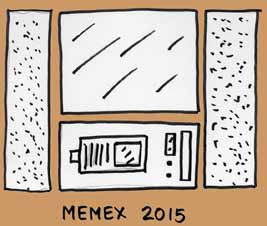
TECHNOLOGY
"All this is conventional, except for the projection forward of present-day mechanisms and gadgetry" -- Vannevar Bush, 1945.

TECHNOLOGY
"All this is conventional, except for the projection forward of present-day mechanisms and gadgetry" -- Vannevar Bush, 1945.
Basic main unit

The basic Memex 2015 will have five main components: the monitor (top-center box, shown at right), the central unit (bottom-center box, shown at right), the portable unit (on the left side of the bottom-center box), the speakers (left and right boxes, shown at right), and storage (not shown -- it sits in the back of the machine). The components can be integrated into one box, or separated. In addition to the portable unit, the central unit contains an infrared sensor, two input jacks, and a Zip 2015 drive.
Video
The base monitor has a 21" diagonal screen, and will be capable of displaying either two pages of text at one time or a high-definition television broadcast (using whatever standard is in effect in 2015). Assuming a pixel dimension of 800 x 1280 and a compression capacity of twice what is available today, a 1-terabyte cartridge will be able to hold about 120 minutes of good-quality full-screen video.
User input
The standard input will be the portable unit that comes with the basic Memex 2015. This portable unit has a stylus, a pressure screen, and handwriting recognition software, and can be used with the main unit anywhere in the house if the optional infrared units are installed. The portable unit can be synchronized with the main unit by plugging it back into its receptacle. As a substitute for the portable unit, users can buy a keyboard or install voice recognition software.
Storage
The advent of full digitization is what will make the Memex 2015 useful and practical. Because all media will be reduceable to digital storage, the Memex 2015 will be able to draw on a standardized memory format for all of its operations.
The storage bays for the main unit are at the back of the machine. The basic configuration has one petabyte of memory, which can be cheaply expanded as needed.
Zip 2015 cartridges, which hold one terabyte of memory in the same size cartridge as the current 100MB Zip cartridges, will cost about the same as current Zip cartridges, $15. Videotape cannot compete with the Zip 2015 on price for performance, and will not be used with the base unit of the Memex 2015.
Bandwidth
Current cable systems provide users with bandwidth similar to a T-1 line. Obviously, that will have to be improved before the Memex 2015 can reach its full potential.
Sound
The basic unit (pictured) will have digital stereo speakers.
Telephony
The Memex 2015 will have an optional telephony unit, which will allow users to integrate telephone operations into their Memex. The telephony unit will include a telephone and a flatbed scanner. Telephone calls can be made either using the phone or using a head set jacked into the main unit. Incoming FAXes will be sent directly into memory; outgoing FAXes will be sent using the scanner (which, of course, can also be used to scan documents).
Price
Technophiles of 2015 will benefit from the same factor that benefits technophiles of today: that people want to have the latest technology, even if they don't use it. (Perhaps there will also be a continuation of the current situation, where the slowest, cheapest computers that can run Microsoft Windows are blazingly fast at running a sane operating system, such as Linux.) Mass production of the basic Memex 2015 will keep its price to about what it costs to buy a personal computer today: $1500-$2000 in 1998 dollars.